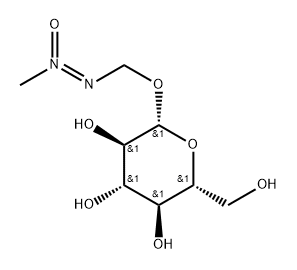Description
Cycasin is a crystalline solid. Molecularweight=252.08; Freezing/Melting point=(decomposes)154℃. Hazard Identification (based on NFPA-704 MRating System): Health 2, Flammability 2, Reactivity 0.
Chemical Properties
Cycasin is a crystalline solid with long nee-
dles.
Safety Profile
Confirmed carcinogen
with experimental carcinogenic and
tumorigenic data. A poison by ingestion. An
experimental teratogen. Mutation data
reported. When heated to decomposition it
emits toxic fumes of NOx.
Potential Exposure
Cycasin occurs naturally, in the seeds,
roots, and leaves of cycad plants which are found in the
tropical and subtropical regions of the world. Nuts from the
cycads are used to make chips, flour, and starch. Cycasin is
not produced or used commercially. The major potential
Exposure is the ingestion of the foods containing cycasin. It is estimated that about 50 55% of the inhabitants of
Guam are potentially exposed (50,000 60,000 persons) to
cycasin. Wastewater from the preparation of the cycad nuts
contain large amounts of cycasin and represents a potential
secondary exposure source.
First aid
If this chemical gets into the eyes, remove anycontact lenses at once and irrigate immediately for at least15 min, occasionally lifting upper and lower lids. Seek medical attention immediately. If this chemical contacts theskin, remove contaminated clothing and wash immediatelywith soap and water. Seek medical attention immediately. Ifthis chemical has been inhaled, remove from exposure, begin rescue breathing (using universal precautions, including resuscitation mask) if breathing has stopped and CPR ifheart action has stopped. Transfer promptly to a medicalfacility. When this chemical has been swallowed, get medical attention. Give large quantities of water and inducevomiting. Do not make an unconscious person vomit.
storage
Color Code—Blue: Health Hazard/Poison: Storein a secure poison location. Prior to working with cycasinyou should be trained on its proper handling and storage. Aregulated, marked area should be established where thischemical is handled, used, or stored in compliance withOSHA Standard 1910.1045. Store in tightly closed containers in a cool, well-ventilated area.
Shipping
UN2811 Toxic solids, organic, n.o.s., Hazard
Class: 6.1; Labels: 6.1-Poisonous materials, Technical
Name Required.
Incompatibilities
Material hydrolyzed under alkaline
conditions
.
Waste Disposal
Disposal of unused product
must be undertaken by qualified personnel who are knowl-
edgeable in all applicable regulations and follow all perti-
nent safety precautions including the use of appropriate
protective equipment. For proper handling and disposal,
always comply with federal, state, and local regulations. At
the time of review, criteria for land treatment or burial
(sanitary landfill) disposal practices are subject to signifi-
cant revision. Prior to implementing land disposal of waste
residue (including waste sludge), consult with environmen-
tal regulatory agencies for guidance on acceptable disposal
practices
.
